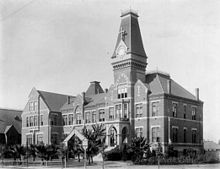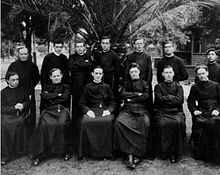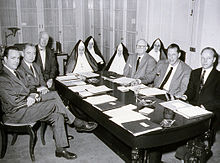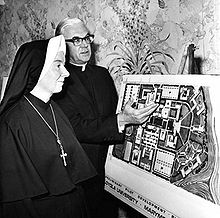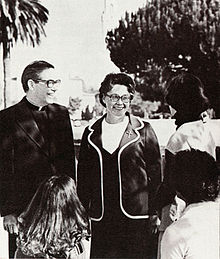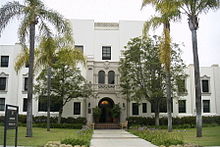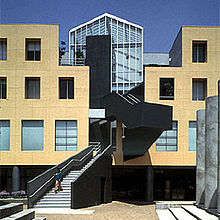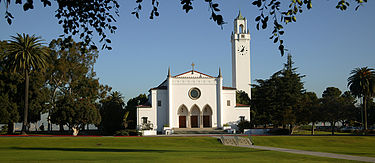- Loyola Marymount University
-
Coordinates: 33°58′11″N 118°25′04″W / 33.969700°N 118.417900°W
Loyola Marymount University 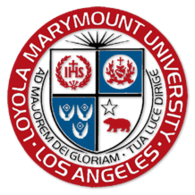
Motto Ad majorem Dei gloriam — Tua Luce Dirige Motto in English For the greater glory of God. — Direct us by thy light. Established 1911 (1865) Type Private Religious affiliation Society of Jesus, Religious of the Sacred Heart of Mary and the Sisters of St. Joseph of Orange (Roman Catholic Church) Endowment $378.8 million (as of June 2007)[1] President David W. Burcham, J.D. Academic staff 507 Students 9,070 Undergraduates 5,797 Postgraduates 3,273 Location Los Angeles, California, United States Campus Urban, 142 acres (57 ha) Conference West Coast Conference Colors Crimson, Navy
Mascot Iggy the Lion Website www.lmu.edu 
Loyola Marymount University (LMU) is a comprehensive co-educational private Roman Catholic university in the Jesuit and Marymount traditions located in Los Angeles, California, United States. The University is one of 28 member institutions of the Association of Jesuit Colleges and Universities and one of five Marymount institutions of higher education.
Loyola Marymount University traces its history through Loyola University, founded in 1911 as the successor to St. Vincent's College which was founded in 1865, and Marymount College, founded in 1933 with its roots in Marymount School which was founded in 1923. Loyola Marymount, which sits atop the bluffs overlooking Marina Del Rey and Playa Del Rey is the parent school to Loyola Law School located in downtown Los Angeles.
As of 2010, Loyola Marymount is one of the largest Roman Catholic universities on the West Coast[2] with just over 9,000 undergraduate, graduate and law school students.[3]
History
The names "Loyola" and "Marymount" have long been associated with Catholic higher education in countries around the globe. Saint Ignatius Loyola, founder of The Society of Jesus, sanctioned the foundation of his order's first school in 1548. The Religious of the Sacred Heart of Mary have conducted educational institutions since their establishment in France in 1849 by Father Jean Gailhac. These two traditions of education have come together in Los Angeles as Loyola Marymount University.
St. Vincent's College
The present University is the successor to the pioneer Catholic college and first institution of higher learning in Southern California.
In 1865, the Vincentian Fathers were commissioned by Bishop Thaddeus Amat y Brusi to found St. Vincent's College for boys in Los Angeles. Father John Asmuth, C.M. served as the first President Rector. The college was originally located in the Lugo Adobe House at the southeast corner of Alameda Street and Los Angeles Street. The building was one of few two-story complexes in the city at that time and had been donated by Vincente Lugo. Although the building no longer stands, its original site is across Alameda Street from the current Union Station, on the Plaza near the southeast end of the city's historic Olvera Street. After two years, the school moved several blocks over. The campus was surrounded by Broadway, 6th Street, Hill Street, and 7th Street. Today, the site is in the heart of Los Angeles's Jewellery District and is known as St. Vincent Court. A decade later, the school moved to a location at Grand Avenue and Washington Boulevard where it remained until being folded into the newly founded Los Angeles College in 1911.[4]
Beginnings of Loyola in L.A.
When the Vincentians pulled out of educational ministry in Los Angeles in 1911, Bishop Thomas Conaty asked the Jesuits to come to Los Angeles and take over St. Vincent's College. Not wishing to assume any of the college's debt, the Jesuits, instead, founded Los Angeles College in 1911. They simultaneously opened their high school division (Loyola High School) and folded the board, faculty, and students of St. Vincent's College into Los Angeles College at a new location made up of several bungalows at Avenue 52 in the Highland Park district of Los Angeles. Father Richard A. Gleeson, S.J. served as the first Jesuit President but the board of the college was initially made up of Vincentian Fathers. Rapid growth prompted the Jesuits to seek a new campus on Venice Boulevard in 1917; with this move, the name of the school was changed back to St. Vincent's College. However, in 1918 the name was once again changed to Loyola College of Los Angeles.[4]
Graduate instruction began in 1920 with the foundation of a separate law school (though instruction at the undergradate level remained all male, women were admitted to the law school). The law school was the first in Los Angeles to admit Jewish students as at the time USC's law school did not.[5] In 1929, the undergraduate division of Loyola relocated under then-President, Joseph A. Sullivan, S.J., to the present Westchester campus in 1929, and achieved university status in 1930 becoming Loyola University of Los Angeles. Loyola Law School did not move with the rest of the university, but moved later to another location just west of downtown Los Angeles.
World War II had a significant impact on Loyola University. As enrollment began to plummet, Father Edward Whelan, S.J., then president, brokered a deal with the US Army to form an officer training program for both Army and Navy officers. The contract allowed the university to remain open during the war and enrollment hit all-time highs as a result of returning veterans taking advantage of the G.I. Bill in the mid to late 1940s. Additionally, Father Whelan recognized the grave injustice of the Japanese internment camps during World War II and hired and housed at Loyola many Japanese Americans returning to Los Angeles after their release from the camps. In 1949, Father Charles Cassassa, S.J., Ph.D., was named president and began one of the most consequential presidencies in the university's history. His work included the formation of a graduate division on the Westchester campus occurred in June 1950, although the graduate work had formed an integral part of the Teacher Education Program during the preceding two years, expanding campus infrastructure, and started the Institute of Human Relations to promote improved racial relations in business and in government. Future Mayor of Los Angeles, Tom Bradley attended the first year-long program held by the Institute of Human Relations and remained life long friends with Father Cassassa. Father Cassassa also continued Father Whelan's legacy of combating racial injustice. In 1950, he forced the school's football team to forfeit a game an away game against Texas Western since the school's rules prevented African-American players, such as Loyola's Bill English, to play on their field.[6] Also during the Cassassa era, the law school moved to its current campus, designed by Frank Gehry, in 1964.
For the most part, Loyola University continued to be an all-male school until its merger with Marymount College in 1973. There were, however, several notable exceptions. The first being that during the summer months, the Loyola faculty offered classes for women religious (Catholic nuns) seeking undergraduate degrees. Many sisters from across Los Angeles and Orange Counties acquired their undergraduate degrees from Loyola. Additionally, women were admitted to several of Loyola's graduate programs prior to the affiliation and merger with Marymount College. Furthermore, there were a several female students admitted to Marymount College who later matriculated into Loyola University during the two school's five year affiliation prior to 1973, primarily Engineering and Business majors which Marymount did not offer.
Beginnings of Marymount in L.A.
In separate though parallel developments, the Religious of the Sacred Heart of Mary began teaching local young women in 1923. Having been invited by Bishop John Cantwell, seven sisters of the Religious of the Sacred Heart of Mary, under the leadership of Mother Cecilia Rafter, R.S.H.M., formed what was first an elementary school and, shortly thereafter, a high school. Within ten years, many young women wished to continue their education with the Marymount sisters beyond high school that Marymount Junior College opened as an all-women's school on the Westwood campus of Marymount High School in 1933. Mother Gertrude Cain, R.S.H.M., served as the first president of the junior college and guided its development into a four year college in 1948, assuming the name Marymount College of Los Angeles. In 1960, having outgrown its shared Westwood campus, Marymount College moved both its two year program and its four year program to the Palos Verdes Peninsula in southwestern Los Angeles.
In 1967 Sister Raymunde McKay, R.S.H.M., D.Phil., the president of Marymount College, extended an invitation to Sister Mary Felix Montgomery, C.S.J., Ph.D., General Superior of the Sisters of Saint Joseph of Orange, to merge Marymount College with St. Joseph College of Orange, a four year liberal arts college for women religious run by the Sisters of Saint Joseph of Orange, which Sister Montgomery accepted. St. Joseph College was originally formed as St. Joseph Teacher's College, a junior college affiliated with The Catholic University of America in 1953. In 1959 it was incorporated as an autonomous, four year institution and assumed the St. Joseph College name. In 1968 Marymount and St. Joseph Colleges merged under the Marymount name with an agreement that the traditions and heritage of both the Religious of the Sacred Heart of Mary and Sisters of St. Joseph of Orange would be carried in the Marymount name. As part of the Marymount College Agreement, Marymount College was administered "co-equally" by the Religious of the Sacred Heart of Mary and the Sisters of St. Joseph of Orange as members of both communities partnered in the governing, staffing, and teaching of Marymount College. Subsequently, St. Joseph College of Orange was renamed Marymount College of Orange. During the academic year, it remained a college for women religious seeking their baccalaureate degrees; college courses were offered to men and women during the summers at the Orange campus. The same year, Marymount College began its affiliation with Loyola University, moving its four year program at the Palos Verdes campus to the Westchester campus of Loyola University. Marymount College then operated on three campuses: Palos Verdes retained its two year program, Orange remained a campus for women religious in Orange County, and Westchester was a campus for both lay and religious women.
Affiliation and merger of Loyola and Marymount
By the mid 1960s, Loyola University of Los Angeles had unsuccessfully petitioned the Archbishop of Los Angeles, Cardinal James Francis McIntyre to allow coeducation at Loyola for several years. In 1967, however, Sister McKay, President of Marymount College, received permission from Cardinal McIntyre to begin affiliation with Loyola University on Loyola’s Westchester campus. Sister McKay and Father Charles Cassassa, S.J., Ph.D., President of Loyola University, held a joint press conference to announce the affiliation. The affiliation of Marymount College and Loyola University began in 1968 when Marymount's four-year program moved to Loyola's Westchester campus; this arrangement (two independent schools on one campus) continued for five years. In 1970, the Student Governments of Loyola University (ASLU—Associated Students of Loyola University) and Marymount College (ASMC—Associated Students of Marymount College) joined to form the Associated Students of Loyola and Marymount (ASLM).
After five years of sharing faculties and facilities, Loyola University and Marymount College merged and assumed the name Loyola Marymount University in 1973. Through this union, the expanded university maintained the century-old mission of Catholic higher education in Los Angeles and incorporated the educational traditions of the Jesuits, Marymount sisters, and Orange sisters into one institution. At this time, ASLM became known as the Associated Students of Loyola Marymount University (ASLMU).
Father Donald Merrifield, S.J., Ph.D., who became president of Loyola University in 1969, continued to serve as the university's president.[3] The academic vice president of Marymount College, Sister Renee Harrangue, R.S.H.M., Ph.D., became the provost. During Merrifield's tenure as president thirteen new buildings were constructed on Loyola Marymount's main campus including the Von der Ahe Communication Arts Building, the George Page Baseball Stadium, Doolan Hall, Gersten Pavilion, Burns Fine Art Center, the Laband Art Gallery, the Leavey Faculty Center and the Loyola Apartments.[7] Merrifield also oversaw the expansion of Loyola Law School's campus in Pico-Union, near downtown Los Angeles.[7] Merrifield and the university commissioned architect Frank Gehry to design the new campus, which was needed to accommodate increased enrollment.[7]
Merrifield also implemented a number of programs to increase minority enrollment, such as financial aid packages and scholarships, and added African American and Latino studies programs.[3][7] He stepped down as president of Loyola Marymount in 1984, but remained the university's chancellor until 2002.[3]
Marymount College's four-year program subsequently separated from its two-year program. The Marymount two-year program remained incorporated as a separate institution and received accreditation in 1971 as the independently run Marymount College, Palos Verdes, which is currently operates in Rancho Palos Verdes, California. In 2010, Marymount College, Palos Verdes received accreditation as a four year institution.
With the merger of Loyola University and Marymount College in 1973, the Sisters of St. Joseph of Orange joined the Society of Jesus and the Religious of the Sacred Heart of Mary as one of the sponsoring religious communities of Loyola Marymount University. Marymount College of Orange was renamed the Orange Campus of Loyola Marymount University. The Orange Campus offered continuing education and summer courses to men and women through the 1980s.
Recent history
In 2007, the university reestablished its presence in Orange County when the Theological Studies Department began offering a two-year Master's program in Pastoral Theology in Orange, California. The first cohort graduated in the Spring of 2009 and the second cohort began the following the fall. The classes are held in the Marywood offices of the Diocese of Orange, not far from the now defunct Orange Campus of Loyola Marymount University.
In articulating a vision for this collegiate enterprise, the Board of Trustees turned to the history of the four-century old Jesuit educational philosophy, as well as to the educational philosophies and traditions of the Marymount and St. Joseph's Sisters.
On March 1, 2010, Loyola Marymount President, Father Robert B. Lawton,S.J., announced his retirement as head of the university, effective at the end of the academic year in May 2010.[8][9] Lawton cited health problems, including a slow recovery from a 2009 back surgery, as the main reason for his departure.[8] He had served as president for eleven years, beginning his tenure in 1999. The LMU board of trustees elected David W. Burcham as the 15th president in a unanimous decision on October 4, 2010.
Campus
 View of Bluff
View of Bluff
LMU sits atop a bluff area 150 acres (61 ha) in the Westchester area of West Los Angeles located in the Del Rey Hills. The original 99 acres (40 ha) were donated to the university by Harry Culver. Xavier Hall, named for St. Francis Xavier, S.J., a companion of St. Ignatius of Loyola, S.J., and St. Robert's Hall, named for St. Robert Bellarmine, S.J., a cardinal and Doctor of the Church, were the first two buildings to be built on the current Westchester Campus. Following their completion in 1929, Xavier Hall housed both the Jesuit Faculty and the students at the time while St. Robert's Hall served as the academic and administrative building.
Sacred Heart Chapel and the Regents Bell Tower were the next non-residential structures to be built on the campus (1953–1955). The Malone Student Center, named for Lorenzo M. Malone, S.J., an alumnus of the university and former Dean of Students and Treasurer of the University, was completed in 1958 and renovated in 1996. LMU now houses 36 academic, athletic, administrative, and event facilities as well as 12 on-campus residence halls (dormitory and suite models) and six on-campus apartment complexes.
The campus houses four large open grass areas not reserved exclusively for athletic play. Alumni Mall and Sunken Gardens provide scenery to the campus that is already laden with views of the entire Los Angeles Basin, Marina del Rey, Playa Vista, Playa del Rey, and the Pacific Ocean.
 University Hall
University Hall
The university's acquisition of University Hall in 2000 brought the campus a new entrance as well as much-needed office and classroom space. University Hall is a facility unique to any academic institution:[citation needed] It was originally constructed for Hughes Aircraft as their world headquarters and converted from an exclusively corporate facility to a building thriving with academic life. LMU acquired the 1,000,000-square-foot (93,000 m2) building in January 2000 from Raytheon, which bought Hughes Aircraft. LMU completed the interior remodel of approximately 250,000 square feet (23,000 m2) in April 2001. The building, which houses the university's Bellarmine College of Liberal Arts, is constructed of steel and concrete and is divided into seven structures above ground. University Hall has over 500,000 square feet (46,000 m2) of floor space and contains over 1,000 parking spaces in three underground levels. The 70,000 square feet (6,500 m2) of atrium space is and will continue to be the venue for many LMU events.
The Princeton Review has recently ranked LMU as having the 7th most beautiful campus in America.[10] CampusSqueeze college e-zine ranked LMU as having the 3rd most beautiful campus in America.[11]
Residence Halls
Co-ed
Single Gender
Suites
Apartments
Hannon - Built 1978. Houses 270 students. Largest apartment complex on campus. Named for Eugenia B. Hannon.
Tenderich - Built 1968. Houses 144 students. Named for Ernst and Gertrude Tenderich.
O'Malley - Built 2000. Houses 160 students. First apartment complex built on Leavey campus. Named for Thomas P. O'Malley.
Leavey 4 - Built 2002. Houses 178 students.
Leavey 5 - Built 2002. Houses 176 students.
Leavey 6 - Built 2005. Houses 176 students. Includes C-Lion convenience store. First LEED Certified apartments on campus.[12]
Sustainability
LMU has a large solar electric rooftop array that generates 868,000 kilowatt-hours of electricity annually, providing 6% of the annual campus electrical needs.[13] The university purchases another 6 percent of its electrical energy through Renewable Energy Credits.[14] LMU has committed to LEED Silver standards for all new construction on campus. There are three LEED-certified buildings on campus. All new and renovated roofing projects include installation of a highly reflective white membrane cool roof.[15] Student sustainability jobs are available in the recycling program, and the student government has a position dedicated to environmental responsibility. Loyola Marymount earned a grade of a "B-" on the College Sustainability Report Card 2010,[16] published by the Sustainable Endowments Institute.[17]
Academics
In addition to being the parent school of Loyola Law School in downtown Los Angeles, Loyola Marymount is the home to six colleges and schools. LMU offers an Air Force ROTC program, an Honors Program in which the students have a different core curriculum, and several year-long, semester, and summer study abroad programs across the Americas, Europe, Africa, Asia, and Australia. Admission to LMU is competitive. Students from every U.S. state attend LMU. Some of the recent honors received by LMU are:
- U.S. News & World Report, in its "Best Colleges 2011," ranked Loyola Marymount 3rd out of schools in the West that offer a full range of masters and undergraduate programs, behind only Trinity University and Santa Clara University. In 2011, LMU scored an 87, up 8 points from the 2010 rankings.[18]
- Named among the “25 cutting edge schools with an eye toward the future” Kaplan’s “You Are Here” College Guide, 2008
- Included in “Best 366 Colleges”(top 15 percent of all colleges in the United States), “Best Colleges in the West”, "Happiest Students" and “10 Most Beautiful Campuses” Princeton Review, 2008[19]
- US News ranked Loyola in its 2010 version of "America's Best Graduate Schools" as tied for 41st best part-time program in America, which places it as the 8th best part-time program in California.[20]
- Named a “top producer” of Fulbright scholars, 2006–07 Institute of International Education.[21]
- Named “Hottest for Hispanics” Newsweek/Kaplan’s “How to Get into College” Guide, 2006[22]
Bellarmine College of Liberal Arts
The Bellarmine College of Liberal Arts includes twenty-five undergraduate programs of study as well as five graduate programs. It embodies the wider University goals of liberal education, which is the heart of the University's core curriculum for all undergraduates. The college is named for the Jesuit scholar, Saint Robert Bellarmine, a cardinal and Doctor of the Church.
College of Communication and Fine Arts
The College of Communication and Fine Arts offers majors in Art History, Communication Studies, Dance, Music, Studio Arts, and Theatre Arts as well as a graduate program in Marital and Family Therapy. The current dean of the College of Communication and Fine Arts is Barbara Busse.
The Department of Music has long been known for its choral organizations. Two choruses provide singing opportunities for a broad cross section of the university community. Promoting the university's long tradition, the 100-voice Concert Choir presents music for mixed voices. The smaller, more advanced Consort Singers presents varying styles of choral music and frequently appears in the Los Angeles area as the ambassador group for the university.
The College of Communication is the parent college of Loyola Marymount's award-winning Debate Team. The Debate Team frequently finishes in top positions in national and international tournaments.
College of Business Administration
 Hilton Center for Business
Hilton Center for Business
The College of Business Administration was started to assist inquisitive minds in learning more about the effective principles and practice of business through foundation building, undergraduate programs, and flexible graduate programs for advancing professionals. It is home to eight undergraduate programs of study as well as an MBA program for graduate studies.
The College of Business Administration’s mission is to educate for ethical leadership. Education for ethical leadership is fostering the development of a frame of mind which encourages people to learn to take action, to motivate others, to achieve results through others, to learn from mistakes, and to take responsibility for organizing scarce resources to achieve desired results. Education for ethical leadership is not just teaching about ethics and leadership as disciplines. It is encouraging people to observe, to think, to learn, and then to perform as ethical leaders in any business function or activity, at any level. It is teaching people to look for opportunities in which to demonstrate their leadership skills and potentials. It is encouraging leaders to be of service to others
Rankings
- Businessweek ranked Loyola Marymount as the 13th best part-time MBA program in America. This places Loyola 3rd in the west behind UCLA and UC Berkeley.[23]
- US News ranked Loyola in its 2012 version of "America's Best Graduate Schools" as tied for 50th best part-time program in America, which places it as the 7th best part-time program in California.[20]
- Entrepreneur Magazine and Princeton Review ranked the Loyola Marymount 17th in undergraduate entrepreneurship and 12th in graduate entrepreneurship.[24]
Frank R. Seaver College of Science and Engineering
The Frank R. Seaver College of Science and Engineering sees its purpose to be the education of principled leaders. It contains thirteen undergraduate programs of study as well as six graduate programs. Graduate programs are offered in civil, electrical and mechanical engineering, in environmental science, in computer science, and in engineering management.
The college is committed to delivering science, engineering, and mathematics education to students through individual attention with emphasis on self-learning, service to society, and ethical behavior. Undergraduate students experience close interactions with the faculty as a result of small class sizes. Students conduct sophisticated state-of-the-art research by working very closely with their professors and they participate in various undergraduate student research conferences and student design competitions.
The College was ranked 19th nationally by US News & World Report's "2005 Best Colleges Guide" in the category of institutions whose highest degree is a bachelor's or master's.
School of Education
 Edward T. Foley Center
Edward T. Foley Center
The School of Education at Loyola Marymount has four undergraduate programs of study (Elementary Education, Secondary Education, Bilingual Education, and Special Education). A student wishing to receive their credential upon graduation majors in any other program and applies to one of the four undergraduate education minors during their sophomore year. Many students seeking a credential in Elementary Education major in the Bellarmine College of Liberal Arts' Liberal Studies program, which is designed to educate one in the various arts and letters they will be teaching children. The School of Education also offers nine graduate programs including a Doctorate in Education.
School of Film and Television
The School of Film and Television, established in 2003 and consolidating LMU's already well-regarded programs in film and television,[25] offers curricula that hold storytelling as their unique centerpiece. SFTV's vision, being grounded in humanism, innovation and diversity, is unique and differentiated for a film school. A range of advanced facilities and equipment are available to students, including a film soundstage, a television stage, editing labs, a screenwriting library, and sound studios. The primary screening venue is the Mayer Theatre.
SFTV offers a B.A. in Production (Film & Television), Screenwriting, Animation, and Recording Arts as well as an M.F.A. in Production (Film & Television) and Screenwriting. Overall, LMU has produced six Student Academy Award winners.[26] Alumni have also garnered several Academy Awards and Emmys.[27]
Loyola Law School
Loyola Law School's Frank Gehry-designed campus[28] is in the Pico-Union neighborhood west of downtown Los Angeles and is separate from the Westchester main university campus.
U.S. News & World Report ranked Loyola Law School 56th[29] in its "America's Best Graduate Schools 2010" feature. Loyola was ranked 21st overall in the annual 2009 Judging the Law Schools rankings.[30]
Loyola ranks higher in guides such as The Princeton Review in addition to the Cooley rankings (also known as the Brennan rankings).[31] The Cooley Rankings ranked Loyola Law School 23rd in the nation in 2008.[32]
For specialty rankings: According to The Princeton Review's 2008 "Best 170 Law Schools" Loyola is:
- 1st in the nation for "Best Classroom Experience"
- 4th in "Professors Rock (Legally Speaking)"
- 9th in "Most Diverse Faculty".[33]
- Loyola's fairly recent Taxation LL.M. program ranks 8th in the nation by U.S. News & World Report[34]
- Loyola's trial advocacy program is ranked 5th in the nation by U.S. News & World Report[34]
- Lawdragon, which ranks and evaluates attorneys and judges, named Loyola #17 in its list of the 25 Leading Law Schools.[35]
Its recently renovated library is one of the largest private law libraries in the western U.S., with a collection of nearly 560,000 volumes.[36]
Including its day and evening J.D. programs, Loyola has a large and diverse student enrollment. It was the first California law school with a pro bono graduation requirement,[37] under which students perform 40 hours of pro bono work.[38] After Hurricane Katrina, Loyola was one of a handful of schools to open its doors to students of law schools in New Orleans who were forced to relocate.[39]
Organization
The governing body of the university is the school's independent Board of Trustees, headed by a Chairman.
The University's executive officer is the President. Prior to 2009, a prerequisite to serve as the University's president was membership in the Society of Jesus, however, the Board of Trustees voted to allow educators not a part of the Jesuit Order to become president. These changes were made at the recommendation of the American Assistancy of Jesuits, the collective body of Jesuits in the United States in response to the declining number of Jesuits as well as those prepared to serve as the president of a major university. See a list of past presidents.
The President is assisted by the Chancellor, Assistant to the President, Director Internal Audit, The Vice President for Mission and Ministry (under whose direction the Office of Campus Ministry and the Center for Ignatian Spirituality operates) and the Vice President for Intercultural Affairs.
The Executive Vice President & Provost reports directly to the President and oversees all campus operations.
The University Cabinet consists of: The President, Executive Vice President & Provost, Senior Vice President & Chief Academic Officer (under whose direction the Deans of the Bellarmine College of Liberal Arts, College of Business Administration, College of Communication and Fine Arts, Seaver College of Science and Engineering, School of Education, School of Film and Television, and University Libraries operate), Senior Vice President for Administration, Senior Vice President & Chief Financial Officer, Senior Vice President for Student Affairs, Senior Vice President for University Relations, and Senior Vice President Fritz B. Burns Dean of Loyola Law School.
The Jesuit Community is headed by a Rector (appointed by the Superior General of the Society of Jesus); the Religious of the Sacred Heart of Mary are led by local coordinator who report to the Provincial Superior of the Western American Province; and the Sisters of St. Joseph of Orange are led by a local superior who reports to the General Superior of the their congregation. Each of the three sponsoring religious communities is represented on the Board of Trustees.
Sponsoring religious orders
LMU is sponsored primarily by three religious orders that have long been associated with education, the Society of Jesus, the Religious of the Sacred Heart of Mary, and the Sisters of Saint Joseph of Orange. Although, other Religious Orders such as the Order of Our Lady of Mount Carmel (Carmelites) and the Sisters of Saint Louis also have members employed on campus.
Society of Jesus
The Jesuit Community of LMU is the largest in the California Province of the Society of Jesus. The campus' Jesuits were housed in Xavier Hall until the recent completion of the new Jesuit Community Complex. LMU is home to 51 Jesuits (2006-2007 academic school year) holding various positions in administrative, staff, and faculty positions throughout the university.
Religious of the Sacred Heart of Mary
The Religious of the Sacred Heart of Mary also house several religious sisters adjacent campus. From 1968 until 1999 the sisters lived on campus in the Thomas and Dorothy Leavey Center. In 1999, they donated the building to the university and moved into residential houses off campus. The Western American provincial center, which had been in the Leavey center, was moved to Montebello, CA. The Marymount sisters sponsor the Marymount Institute for Faith, Culture, and the Arts which attempts to preserve the transformative educational tradition of the Religious of the Sacred Heart of Mary and promotes a dialogue between faith and culture as expressed in fine, performing, literary and communication arts.
Sisters of Saint Joseph of Orange
Like the Jesuits and Marymount Sisters, the Sisters of Saint Joseph of Orange play a great role in preserving the Roman Catholic identity of the school. Several sisters of the order reside adjacent to the campus, working in administrative, staff, and faculty roles.
Campus ministry
Loyola Marymount's Office of Campus Ministry is a component to the promotion of the university’s mission and identity.
Founded in 1911 as the University Chaplain, this division became known as Campus Ministry in 1973 with a stipulation that the Director would be a Jesuit. By 1986 this requirement was waived when Sr. Mary Margaret ("Peg") Dolan, R.S.H.M. became the director. Dolan, an alumna of Marymount College's class of 1958, received her Master's from LMU in 1974 and also served the university as a housing director, campus minister, alumni chaplain, director of campus ministry, director of alumni relations, resident chaplain since, and alumni chaplain 1973. In 2008, as part of the university's Centennial Capital Campaign, it was announced that a $8-million fundraising goal was set to endow the office as the "Peg Dolan, RSHM Campus Ministry Center" in honor of Dolan's contributions to the university. In 2008 the university asked her to address the class of 2008 at the undergraduate commencement exercises and she was awarded an honorary doctorate. At the dedication ceremony in September 2008, over 700 alumni returned to campus to honor her legacy at the university. When Dolan died in 2009, over 1000 people returned to campus for two days of liturgies celebrating her life.
Located at the north end of the University, Sacred Heart Chapel is the main worship space on campus. A basilica-style church, Sacred Heart has two side altars and the Mary chapel, which is located behind the crucifix, in addition to the main chapel space. The chapel is lined by tall stained glass windows. Each window bears the seal of one of the 28 other Jesuit Universities in the United States; additionally, following the 1973 merger, edged glass window of the other 4 Marymount colleges and universities in the United States were added.
Mission statement
Loyola Marymount University declares its mission and purpose to be the following: the service of faith and the promotion of justice, the encouragement of learning, and the education of the whole person. Being rooted in Jesuit tradition, Loyola Marymount University follows in their strong dedication to education. A committee on campus meets regularly to analyze the campus' overall strengths and weaknesses in fulfilling this mission statement.
The Marymount Institute for Faith, Culture, and the Arts
Founded in 1991, the Marymount Institute was designed to help strengthen the legacy and contributions of the Marymount tradition at LMU, and encourages interdisciplinary and intercultural scholarly and artistic activity in the form of research, publication, exhibits, performances, conferences, seminars, and lectures.
2008 saw the opening of the Marymount Institute Press. Itself an imprint of Tsehai Publishers and Distributors, the MIP was founded by the Ethiopian-born journalist, publisher, and social activist, Elias Wondimu, and already has two publications to its credit: "Panim el Panim: Facing Genesis, Visual Midrash" and "A Journey into Love: Meditating with Piers Plowman".
The President's Marymount Institute Professor in Residence is Nobel Laureate Wole Soyinka.
Athletics
Athletic teams at Loyola Marymount are known as Lions; the school's primary athletic affiliation is with the West Coast Conference. While LMU has had success in several sports, it is probably best remembered for its men's basketball teams between 1985 and 1990, with Paul Westhead as coach and for the death of star player Hank Gathers (#44), who collapsed during the second round of the WCC tournament on March 4, 1990, and for his friendship with teammate Bo Kimble (#30). Their jerseys have been retired at LMU. To this day, LMU games occupy the top five spots in the list of highest-scoring NCAA Division I basketball games.
Especially well-remembered was the 1990 team, led by Gathers and Kimble until tragedy struck in the WCC tournament. Gathers collapsed during a game and died due to a previously diagnosed heart condition. Playing for their fallen teammate, the Lions advanced to the Elite Eight (regional final) of the NCAA tournament before falling to eventual champions UNLV.
The primary indoor athletic facility is Gersten Pavilion.
Texas Rangers starting pitcher C. J. Wilson attended and pitched at Loyola Marymount in 2001.
LMU Softball holds many records. It owns more titles than any other PCSC (Pacific Coast Softball Conference) team, with three in 2003, 2005, and 2007. In 2007, Tiffany Pagano and LMU beat UCLA 4-2 in the Los Angeles regional in the NCAA Tournament, to mark their first win over the Bruins, and the first time that UCLA had not won a regional and advanced to the Women's College World Series.
Student government
ASLMU, The Associated Students of Loyola Marymount University, is the functioning student government. The government body is composed of an Executive Branch, composed of the Management Team and Cabinet Departments; a Legislative Branch, composed of the Senate; and a Judicial Branch, composed of the Judicial Committee. The only elected positions are those of the President, Vice President and the Senate. Unlike the senators, the President and Vice President have a limited term of two years.[40]
Student media
Loyola Marymount has a rich history of student created and directed media.
Los Angeles Loyolan newspaper
The Los Angeles Loyolan newspaper has been published for over 80 years. It was originally titled "The Cinder" for the cinders kicked up by the trains passing the downtown campus of St. Vincent's College. In 2007, The Loyolan moved from its long standing weekly Wednesday publication schedule to a twice a week - Monday and Thursday - schedule. The Loyolan is supported by its advertising department which has historically paid from 80% to 100% of the cost of publication. The Loyolan's regular sections include "News", "Opinions", "Sports", "Arts & Entertainment", and "Classified Ads".
In 2005, the paper won the Columbia Scholastic Press Association award for "Best Four-Year Weekly Tabloid."
Tower Yearbook
Over the years, the Loyola University Los Angeles yearbook was known by several titles including the Lair Annual. After the merger the university began publishing the annual Tower Yearbook which is financed through a mandatory annual student yearbook fee (collected along with tuition).
The student-run yearbook at Loyola Marymount University was named "Best in Show" at the 85th Annual National College Media Conference in St. Louis, Mo. on October 30. "The Tower" took first place in the "Yearbook 300-Plus" category among other prestigious colleges from around the nation. The 2006 yearbook was honored for its unique design and its "re: 2006" theme. Director of Student Media, Tom Nelson, said "Editor in Chief Ashlee Goodwin and the entire Tower staff put an incredible amount of effort into the 2006 yearbook, which was not only the best but the largest ever produced at Loyola Marymount University."
Campus radio
KXLU (88.9 FM) is an FM radio station broadcasting out of Loyola Marymount University in southwest Los Angeles, California. It was first on the air in 1957, and recently celebrated its 50th anniversary. It is a non-commercial college radio station that plays many styles of music broadly classified under rock, specialty, fine arts, and Latin jazz. KXLU has an annual fundraising drive known as "fundrazor" which supports the station's ongoing operation. The station has a large following in the Los Angeles area.
KXLU is also the 'flagship' station for LMU athletics featuring every Lions Men's basketball game each season.
The university boasts both an AM/closed circuit and FM radio station. KLMU is the other radio station on LMU's campus, which can also be streamed online for listeners across the country. KLMU offers undergraduates an opportunity to host their own radio shows.
ROAR Network
ROAR Network is the newest student media on-campus. It provides a forum for student produced programming to be broadcast both via the on-campus cable TV system and, eventually, via the Public-access television cable TV system(s). ROAR Network is the only TV Station made for, and run by students on the LMU campus. The station provides student produced programming every two weeks, with its primetime block from 10:00 p.m. to 2:00 a.m. every night. Current and previous episodes are also available for viewing and download online at ROAR Network's Website
Center for Service and Action
Unique to Loyola Marymount is its Center for Service and Action (CSA). Dedicated to fostering the Jesuit principles of the service of faith and promotion of justice, CSA offer students opportunities to serve the campus and surrounding communities. The mission of CSA is to educate and form men and women with and for others, especially with and for the disadvantaged and the oppressed.
The Center for Service and Action resulted in LMU being awarded the President's Higher Education Community Service Honor Roll with Distinction, the highest federal recognition a school can receive for civil service.[41]
One of the many opportunities provided by CSA to students looking to do service work is the Alternative Break Program. LMU's Alternative Breaks program promotes service and cultural exchange on the local, national, and international level through hands-on, community-based learning. Students are immersed in diverse contexts throughout the world with concrete challenges that heighten social awareness.
Service organizations
CSA also oversees LMU's student service organizations. The seven service organizations work to help the university and surrounding community of Los Angeles.
Each Service Organization has its own unique mission, history, charism and organizational structure. The members of these organizations make themselves available for on-campus service as well as on-going commitments to serve at specific non-profit agencies in Southern California. Each organization has a moderator and a chaplain (though in some of the organizations the same priest or woman religious serves as both moderator and chaplain).
The Center for Service and Action works with the service organizations in fostering on-campus service and community service as well as reflecting upon their experience of service. CSA coordinates communication between the leadership of these organizations, the Service Organization Council. CSA also coordinates the distribution of the On-Campus Service Requests.
The organizations and their respective dates of founding are Crimson Circle (1929), Belles (1960), Gryphon Circle (1968), Ignatians (1981), Sursum Corda (1992), Marians (2003), Magis (2003), and Creare Service organizations (2009).
Greek life
LMU is also home to a number of campus Greek Organizations. The campus fraternities are as follows: Alpha Delta Gamma (1952), Sigma Chi (1991), Sigma Phi Epsilon (1996), Sigma Lambda Beta (1999), Lambda Chi Alpha (2002), Beta Theta Pi (2005). The campus sororities are as follows: Alpha Phi (1976), Delta Gamma (1981), Delta Zeta (1986), Kappa Alpha Theta (1999), Delta Sigma Theta (Divine Nine)(2000), Sigma Lambda Gamma (2000), Pi Beta Phi (2002), Delta Delta Delta (2005), and Sigma Gamma Rho (2006)(Divine Nine. In addition the Kappa Sigma fraternity has represented on campus by the Pi-Beta chapter since 2007, though as of 2011 the chapter remains unrecognized by the Loyola Marymount Administration40.
Notable faculty and alumni
References
- Notes
- ^ http://www.lmu.edu/giving/questions/Endowment_Q_A.htm?quot;%20title=
- ^ http://www.lmu.edu/about/Quick_Facts.htm
- ^ a b c d Thursby, Keith (2010-03-03). "Donald P. Merrifield dies at 81; former president of Loyola Marymount". Los Angeles Times. http://articles.latimes.com/2010/mar/02/local/la-me-donald-merrifield2-2010mar02. Retrieved 2010-03-10.
- ^ a b Jay Berman, "The School the City Forgot," Los Angeles Downtown News, December 19, 2007, http://www.ladowntownnews.com/articles/2007/12/24/news/news03.txt
- ^ Loyola Law School, History of Loyola Law School, http://alumni.lls.edu/history.html
- ^ Aaron Smith, "No One Left Behind, LMU Magazine, Summer 2010, http://magazine.lmu.edu/archive/2010/no-one-left-behind
- ^ a b c d "Former LMU President Donald Merrifield, S.J. Dies at 81". Loyola Marymount University. http://newsroom.lmu.edu/newsroompressreleases/Former_LMU_President_Donald_Merrifield__S_J__Dies_at_81.htm. Retrieved 2010-03-10.
- ^ a b Riparbelli, Laura (2010-03-01). "Lawton resigns as University president: Fr. Robert B. Lawton, S.J., steps down after 11 year term". Los Angeles Loyolan. http://www.laloyolan.com/mobile/news/lawton-resigns-as-university-president-1.2174838. Retrieved 2010-03-15.[dead link]
- ^ Gordon, Larry (2010-03-03). "President of Loyola Marymount University to step down, cites back surgery". Los Angeles Times. http://latimesblogs.latimes.com/lanow/2010/03/loyola-marymount-president-to-retire-citing-back-surgery.html. Retrieved 2010-03-15.
- ^ The Princeton Review
- ^ 11Alive.com | Atlanta, GA | Top 20 Most Beautiful Colleges
- ^ "Leavey Student Apartments 4, 5 & 6". Website. http://www.morleybuilders.com/node/389. Retrieved 22 August 2011.
- ^ "LMU Helps Lead the Way to a Greener L.A.". Loyola Marymount University. http://www.lmu.edu/Page37887.aspx?DateTime=633215729400000000&PageMode=View. Retrieved 2009-09-10.
- ^ "Energy Management". Loyola Marymount University. http://www.lmu.edu/sites/Community_home/Green_LMU/The_Campus/Energy.htm. Retrieved 2009-09-10.[dead link]
- ^ "Built Environment". Loyola Marymount University. http://www.lmu.edu/sites/Community_home/Green_LMU/The_Campus/Built_Environment.htm. Retrieved 2009-09-10.[dead link]
- ^ http://greenreportcard.org/report-card-2010/schools/loyola-marymount-university
- ^ http://www.endowmentinstitute.org
- ^ "http://colleges.usnews.rankingsandreviews.com/best-colleges/masters-universities-west-rankings
- ^ http://www.lmu.edu/lmunews/Kaplan_Says_LMU_is_Cutting-Edge.htm?DateTime=633240813000000000&PageMode=View
- ^ http://www.iie.org/en/Research-and-Publications/Open-Doors/Data/US-Study-Abroad/Institutions-by-Undergraduate-Participation/2006-07
- ^ http://www.hispanicbusiness.com/news/2006/10/18/ceo_and_publisher_of_hispanicmarket_publications.htm
- ^ http://www.businessweek.com/interactive_reports/bschools_ptmba_rankings_2009.html?chan=magazine+channel_special+report
- ^ http://cba.lmu.edu/academicprograms/centers/entrepreneurship/Rankings.htm
- ^ Johnson, Ross (2005-05-22). "To Be as a City Upon a (Hollywood) Hill". The New York Times. http://www.nytimes.com/2005/05/22/movies/22john.html. Retrieved 2010-05-11.
- ^ http://old.oscars.org/saa/winners/wins_most.html
- ^ http://sftv.lmu.edu/alumni.htm
- ^ [1]
- ^ "America's Best Graduate Schools 2009". U.S. News & World Report. http://www.usnews.com/usnews/edu/grad/rankings/law/brief/lawrank_brief.php.
- ^ 2009 edition of Judging the Law Schools (accessed May 2, 2009)
- ^ [2]
- ^ [3]
- ^ http://www.princetonreview.com/law/research/profiles/rankings.asp?listing=1035876<ID=5&intbucketid=
- ^ a b [4]
- ^ [5]
- ^ [6]
- ^ [7]
- ^ [8]
- ^ [9]
- ^ http://aslmu.lmu.edu/constitution_final.pdf
- ^ "LMU Receives Award for Service" - http://www.lmu.edu/Page44969.aspx
40 Kappa Sigma National Chapter List
External links
- Loyola Marymount University
- Official LMU athletics site
- LMU Lions Den Athletics Message Board
- LMU Loyolan Student Newspaper
- Detachment 040, Air Force ROTC
- Loyola Law School
- LMU School of Education
Categories:- Loyola Marymount University
- Independent Colleges of Southern California
- Jesuit universities and colleges in the United States
- Roman Catholic universities and colleges in the United States
- Universities and colleges in Los Angeles County, California
- Congregation of the Sisters of Saint Joseph
- Educational institutions established in 1911
- Religious organizations established in 1911
- Educational institutions established in 1865
- National Association of Independent Colleges and Universities members
- Schools accredited by the Western Association of Schools and Colleges
Wikimedia Foundation. 2010.


